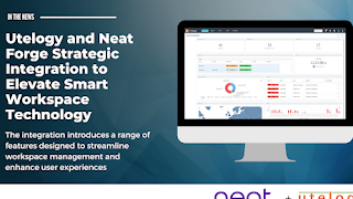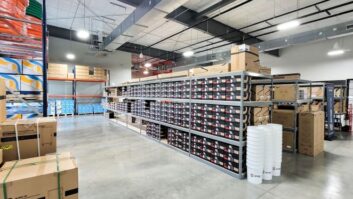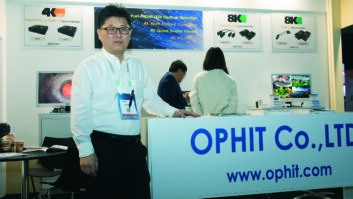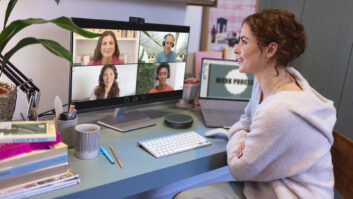 The past eighteen months has had a big impact on the way we all communicate and engage with each other on a daily basis, in both our personal and work lives.
The past eighteen months has had a big impact on the way we all communicate and engage with each other on a daily basis, in both our personal and work lives.
But it also allowed us to improve and innovate with new AV solutions that are now shaping how we stay informed and connected.
Technological advancements in audio and visual communications were already in place pre-pandemic, but were viewed by many as the reserve of large enterprise corporations. However, the period forced all industries to look at new ways to engage and collaborate, to embrace audio technology and to understand the full potential it offered.
Apart from basic operational procedures – such as who is working where, controlling, and redesigning space within the workplace, providing flexibility for all employees and ensuring the security of any sensitive material outside of the physical office – other key issues included how to conduct and maintain effective communications and efficient collaboration.
WEAK TOOLS
At the beginning of the pandemic, the collaboration tools in place within many organisations simply weren’t compatible or powerful enough to deal with the requirements needed to adapt to these new ways of working with colleagues and clients. Investment was required, along with product know-how and support to implement systems capable of performing adequately.
For some organisations, especially those with distributed workforces and a global client base, this ‘new’ way of collaboration was already part of the daily work process, with meeting rooms designed accordingly, providing acoustically treated spaces and AV tools that met the requirements needed to conduct business comfortably and effectively.
REMOTE COLLABORATION
But for other, smaller organisations and those that focussed on the physical work environment and positive vibe of the workspace, the hybrid working model has raised more questions than answers. Many quickly realised that investment was needed for flexible, IT-friendly systems that could meet the requirements of remote collaboration and internal discussions.
Finding the right balance of collaboration, security and infrastructure created a new challenge for CIOs and IT teams working with complicated networked systems, who were also charged with maintaining the safety of staff while still delivering business continuity.
Organisations also had to give consideration to the office workspace plan to guarantee social distancing between desks, with small meeting spaces being replaced by larger rooms – becoming the new “huddle rooms” – with more emphasis on remote collaboration.
From the employee’s perspective, simply turning on the laptop at home to collaborate was met with frustration as it quickly transpired that most, if not all, in-built microphones and camera technology was simply not professional nor adequate enough to cope with serious discussion and collaboration. This challenge can also have a negative impact in the productivity of a company that, without proper investment on appropriate conferencing equipment, can lead in turn to frustrated employees, who spend valuable timing struggling with technical and audio issues.
Sound cutting out, echo, background noise, bandwidth issues, and the problem of not being able to hear other participants, are negative factors that can directly impact the success of a meeting, leading to the loss of customer trust, or even damaging the reputation of a brand.
SHURE-FIRE SUPPORT
As a manufacturer of audio solutions, Shure has a rich heritage in audio innovation and development, as well as boasting a network of experienced engineers who understand the product and can identify and implement systems that perform efficiently and effectively, while solving user’s problems. During the transition from the old working practices to the hybrid, WFH/office model, Shure provided support to all of its customers to enable a smooth transition and keep business disruption to an absolute minimum.
As the hybrid model continues to evolve, one argument is that we are potentially witnessing a divide in communications, with the more affluent organisations capable of greater investment in more powerful systems, and smaller organisations unable to communicate with colleagues and clients as effectively.
To combat this, and to further highlight our commitment to provide extraordinary audio for every client, Shure acquired Stem Audio to offer a range of products that complemented our existing portfolio – providing customers with high-quality audio equipment that can be easily installed in all types of rooms to meet and exceed their individual needs.
BESPOKE SOLUTIONS
With the Stem Ecosystem portfolio now available alongside our Microflex offering, bespoke solutions can be designed to adapt to all types of rooms, and for situations that require a more straightforward audio and control solution (specifically for videoconferencing and streamlined installation) which local IT teams can deploy in standard meeting rooms. Small businesses, or simply smaller meeting rooms within the context of a larger AV project, can now rely on a first-class audio experience.
A reliable and broadcast-quality audio technology that is, at the same time scalable, is fundamental to ensuring that the workforce has the right tools for turning meeting rooms into collaboration spaces where all participants, even the ones attending remotely, feel involved and engaged – without adding any technological difficulty.
With international travel not expected to resume on a large scale for some time to come, richer office-based experiences will continue to be in demand. Having the ability to enable workers to go back to the office when appropriate is an important element of corporate strategy.
Flexibility is also required, and it is likely that the hybrid working model will continue to be adopted, with workers traveling into offices one or twice a week, working from home or remote locations for the rest. This will result in many workers operating from multiple locations as they traverse socially distanced traditional meeting and huddle rooms, remote locations, and home offices.
To ensure the maximum productivity and utmost worker comfort, meeting equality must be maintained to ensure that no employee feels left out of the conversation or is under-supported by their employers.
CLEAR COMMUNICATION
As this new way of working continues to evolve, what is certain is the need for clear communication, based on videoconferencing technology that is efficient, effective, and user-friendly, as well as the tools required to provide intelligible speech and great audio throughout. It is important to understand that videoconferencing is not only a fixture of the current environment, but here to stay indefinitely. Therefore, having an audio technology and collaborative tools that allow users to participate and enjoy their meetings at any given time, is more essential than ever before. Ongoing developments in AV technology continue to create solutions that now offer the employer and workforce smart workspaces for both the home and the office so that wherever the future drives us, we can
all be prepared.







